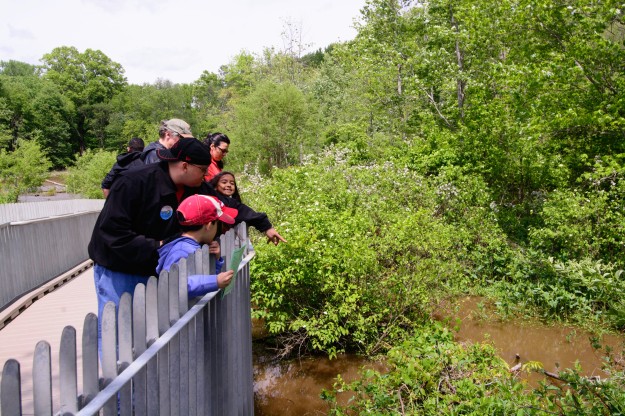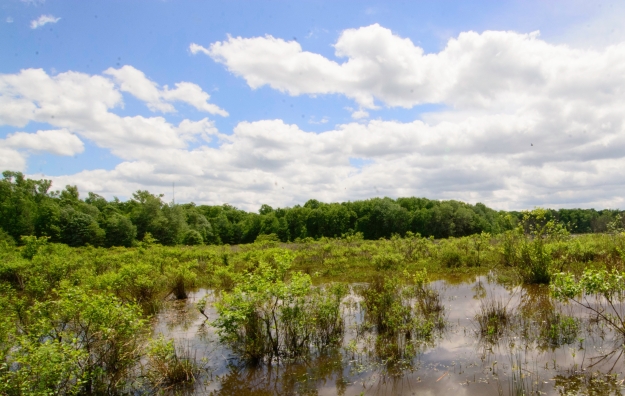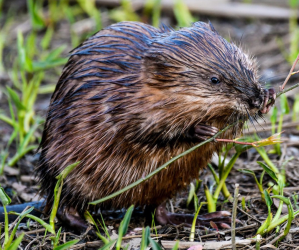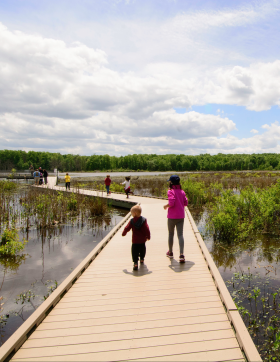It’s deeper, it’s bigger, and it’s healthier. There’s more plant and animal diversity in the restored wetland at Huntley Meadows.
 In a massive project that spanned more than two decades, the Central Wetland at Huntley Meadows Park was restored. On May 10, 2019, the park will mark the fifth anniversary of the The Central Wetland Restoration Project’s completion, and it’s a good time to review the outcome of the effort.
In a massive project that spanned more than two decades, the Central Wetland at Huntley Meadows Park was restored. On May 10, 2019, the park will mark the fifth anniversary of the The Central Wetland Restoration Project’s completion, and it’s a good time to review the outcome of the effort.
Five years down the line, the wetland is showing noteworthy improvements, including more biodiversity and healthy ecological function. The restoration increased the size and depth of the wetland. Berms were installed, and management now can hold back or release wetland waters. Since the project’s completion, Huntley Meadows staff have been actively managing the wetland.
 Wetland management decisions are based on scientific data collected from the wetland. That data includes water levels, wetland plant communities and survey results. There’s a weather station in the wetland that provides invaluable data by recording more than 20 parameters every 15 minutes. The information it provides includes water levels, gate levels and rainfall. Staff conduct annual vegetation surveys through aerial photo analysis and ground vegetation surveys in the wetland to determine the diversity of plant life and the trends in the plant communities. The weather station data and the vegetation surveys are critical elements that are required to make science-based decisions and reach goals set for the wetland.
Wetland management decisions are based on scientific data collected from the wetland. That data includes water levels, wetland plant communities and survey results. There’s a weather station in the wetland that provides invaluable data by recording more than 20 parameters every 15 minutes. The information it provides includes water levels, gate levels and rainfall. Staff conduct annual vegetation surveys through aerial photo analysis and ground vegetation surveys in the wetland to determine the diversity of plant life and the trends in the plant communities. The weather station data and the vegetation surveys are critical elements that are required to make science-based decisions and reach goals set for the wetland.
The wetland requires significant maintenance to ensure that the data being collected is quality data. Maintenance also assures the wetland infrastructure that was installed performs properly. The weather station requires regular cleaning, calibration and repair, and the integrity of the berm must be maintained to reduce any chance of major issues due to flooding and erosion. Native vegetation is monitored and enhanced annually to make sure the soil on the berm remains stable. It can be affected by foot traffic.
 The central wetland is the focus of many scientific research projects that are critical to understanding the effects management has on the wetland. Bird surveys are conducted weekly to track bird diversity and abundance. Redheaded woodpeckers and prothonotary warblers have become more common since they started breeding in the wetland over the past five years.
The central wetland is the focus of many scientific research projects that are critical to understanding the effects management has on the wetland. Bird surveys are conducted weekly to track bird diversity and abundance. Redheaded woodpeckers and prothonotary warblers have become more common since they started breeding in the wetland over the past five years.  Marsh birds such as rails and bitterns are of particular interest. Spring breeding bird surveys are conducted, and in 2015 Virginia rails bred in the Central Wetland for the first time in almost 20 years. Frog call surveys are conducted every year to monitor populations. Management also extends to invasive plants and animals, including the northern snakehead fish (Channa argus), which has become naturalized. Most of these surveys could not be conducted without the help and generous support of volunteers.
Marsh birds such as rails and bitterns are of particular interest. Spring breeding bird surveys are conducted, and in 2015 Virginia rails bred in the Central Wetland for the first time in almost 20 years. Frog call surveys are conducted every year to monitor populations. Management also extends to invasive plants and animals, including the northern snakehead fish (Channa argus), which has become naturalized. Most of these surveys could not be conducted without the help and generous support of volunteers.
 The surveys, projects and weather station data collected provide vital information used to guide wetland management plans and decisions. Those plans have to be flexible because the wetland is completely dependent on stormwater for its life. Staff can lower wetland water levels by opening gates to release water. However, raising water levels requires rainfall and stormwater flow in East Barnyard Run, the wetland’s feeder stream. The typical annual water routine in the wetland follows the natural hydrologic cycle — high water in winter, falling water levels in the spring, low water in the summer, and rising water levels in the fall — but the routine can’t become a pattern. It is important to vary the timing and elevation of seasonal water levels in the wetland each year to prevent a pattern that potentially favors specific species over diversity. Erratic cycles lead to an amazing diversity of vegetation and wildlife. Based on the park’s annual vegetation surveys, The Central Wetland vegetation and wildlife are responding very well to the new hydrologic cycles.
The surveys, projects and weather station data collected provide vital information used to guide wetland management plans and decisions. Those plans have to be flexible because the wetland is completely dependent on stormwater for its life. Staff can lower wetland water levels by opening gates to release water. However, raising water levels requires rainfall and stormwater flow in East Barnyard Run, the wetland’s feeder stream. The typical annual water routine in the wetland follows the natural hydrologic cycle — high water in winter, falling water levels in the spring, low water in the summer, and rising water levels in the fall — but the routine can’t become a pattern. It is important to vary the timing and elevation of seasonal water levels in the wetland each year to prevent a pattern that potentially favors specific species over diversity. Erratic cycles lead to an amazing diversity of vegetation and wildlife. Based on the park’s annual vegetation surveys, The Central Wetland vegetation and wildlife are responding very well to the new hydrologic cycles.
People outside the Fairfax County Park Authority have noticed the project’s successes. Over the past five years, the Wetland Restoration Project has received more than 10 awards, including the prestigious Virginia Governors Gold Medal Environmental Excellence Award in 2017 and the American Counsel of Engineering Companies Engineering Excellence Award in 2014.
Staff will continue to manage the wetland water levels and plant communities to create the best habitat for a diverse array of wildlife species. We are seeing positive results in the vegetation and wildlife to date, and we anticipate the best is yet to come.
Author Dave Lawlor is the Natural Resource Manager at Huntley Meadows Park. Park Authority photographer Don Sweeney and park visitor Jane Gamble provided the photos.
